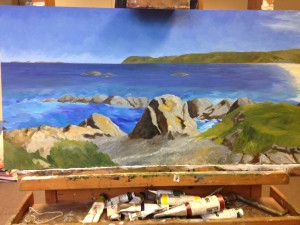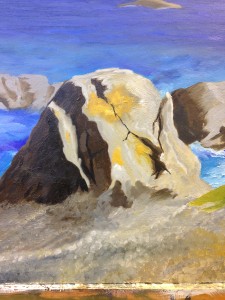|
|
 For the last day of painting, I had to do those awkward, awkward things that most people do not notice. There are ways to transition most good paintings into better paintings, at the end of the process, with light touch work. Most people would not be able to spot the difference, but a highlight that makes the eye pause on something or a deepening of a colour that makes the surroundings look brighter will make a painting better without the viewer being able to articulate why. To finish off the picture, I inched the sky in around the lighthouse, added more pebbles, and highlighted rocks that had been too wet to make fully angular on day 2. I added a scrape of pale paint to the house to make it brighter but not bigger, relying on the optical effect of it standing out, rather than risk making it look too big for the cliff. I added and removed a bright light coming from the lighthouse, deeming that the light blob itself was just too big. That left a faint aura effect which added to the look of the lighthouse being very distant. Finally, I stared at the big central rock and then almost entirely repainted it. For the last day of painting, I had to do those awkward, awkward things that most people do not notice. There are ways to transition most good paintings into better paintings, at the end of the process, with light touch work. Most people would not be able to spot the difference, but a highlight that makes the eye pause on something or a deepening of a colour that makes the surroundings look brighter will make a painting better without the viewer being able to articulate why. To finish off the picture, I inched the sky in around the lighthouse, added more pebbles, and highlighted rocks that had been too wet to make fully angular on day 2. I added a scrape of pale paint to the house to make it brighter but not bigger, relying on the optical effect of it standing out, rather than risk making it look too big for the cliff. I added and removed a bright light coming from the lighthouse, deeming that the light blob itself was just too big. That left a faint aura effect which added to the look of the lighthouse being very distant. Finally, I stared at the big central rock and then almost entirely repainted it.
 The problem with the large rock is that it competes with the other rocks in the foreground. The cluster over to the left are scratchy and half-completed and are designed not to hold the eye. However, that means that they have a certain style and the central rock had to fit in with that style while being aloof from it. Metaphors range from the central gem of a cluster to the yolk of a fried egg. A rock that stands out from other rocks is a difficult call, given that they are made of the same thing. I had to cover the scratchiness off the central planes with strokes, but I wanted to keep the pentimenti – the directional evidence of painting underneath other paint. When I did that on the sky, I did it largely at random, and it let the sky fade out and backwards. This time, it all had to be planned. Fortunately, the lichen allowed for changes of tone and colour without forcing me to add too many shadows. I did add more cracks, cutting up areas of brushwork so that they looked more like fractured plates of rock. I deepened cracks that existed, warmed the grey of the rock with a little of the ochre that was making the lichens, and rebuilt the shadowy area, blending it back down into the pebbles. The seabound rocks all had to have their shadowy and light parts checked, to be certain the foreground lifted away from them by contrast. Once I had added the shadow of the rock on the ground, over the drift of shattered pieces, it fitted into the landscape well. The problem with the large rock is that it competes with the other rocks in the foreground. The cluster over to the left are scratchy and half-completed and are designed not to hold the eye. However, that means that they have a certain style and the central rock had to fit in with that style while being aloof from it. Metaphors range from the central gem of a cluster to the yolk of a fried egg. A rock that stands out from other rocks is a difficult call, given that they are made of the same thing. I had to cover the scratchiness off the central planes with strokes, but I wanted to keep the pentimenti – the directional evidence of painting underneath other paint. When I did that on the sky, I did it largely at random, and it let the sky fade out and backwards. This time, it all had to be planned. Fortunately, the lichen allowed for changes of tone and colour without forcing me to add too many shadows. I did add more cracks, cutting up areas of brushwork so that they looked more like fractured plates of rock. I deepened cracks that existed, warmed the grey of the rock with a little of the ochre that was making the lichens, and rebuilt the shadowy area, blending it back down into the pebbles. The seabound rocks all had to have their shadowy and light parts checked, to be certain the foreground lifted away from them by contrast. Once I had added the shadow of the rock on the ground, over the drift of shattered pieces, it fitted into the landscape well.
Finally, my client asked about the possibility of putting in a seagull, but as I would have had to rebuild the rock and most of the sea, I suggested otherwise. His suggestions had been helpful throughout, but this was something I would have had to have planned for beforehand, and it would have added an extra day to the time logged. We agreed on a pure landscape devoid of any figure, and I got on with cleaning my brushes. After that, there were two more things to do. Hurrying up the frame from the framers and cutting 2mm off the painting to fit it in (these things happen) was one of them. The other was much more fun.
 As I mentioned in day 1, this was a planned stitch-up. I generated an invoice for an entirely imaginary artist, Matthias Cook, and press-ganged a friend of mine into acting as an artist. It took two sentences to persuade him, after which he threw himself into the role entirely. We wrapped up the present according to how Matthias would wrap it, rather than in the utilitarian bubble wrap I used for the other picture going to the same client. Meanwhile, Client A was pleased at his reputation for knowing everyone in Cambridge. By some amazing coincidence, Matthias worked at the same building as the artist, Diana Probst, who was making his own Secret Santa present. The only downside was being asked to deliver both because Matthias had not been efficient in keeping people informed of where he was and what he was doing. Fortunately for everyone concerned, Matthias had a camper van I could borrow… After the present was unwrapped, Client A did remark that it looked like Matthias had been taking lessons from me, but until he was safely out of range of Client B, nobody ‘fessed up. Client A only briefly lost control of his jaw, and then he decided that explained a lot, and elected to blame his brother for everything. Win! As I mentioned in day 1, this was a planned stitch-up. I generated an invoice for an entirely imaginary artist, Matthias Cook, and press-ganged a friend of mine into acting as an artist. It took two sentences to persuade him, after which he threw himself into the role entirely. We wrapped up the present according to how Matthias would wrap it, rather than in the utilitarian bubble wrap I used for the other picture going to the same client. Meanwhile, Client A was pleased at his reputation for knowing everyone in Cambridge. By some amazing coincidence, Matthias worked at the same building as the artist, Diana Probst, who was making his own Secret Santa present. The only downside was being asked to deliver both because Matthias had not been efficient in keeping people informed of where he was and what he was doing. Fortunately for everyone concerned, Matthias had a camper van I could borrow… After the present was unwrapped, Client A did remark that it looked like Matthias had been taking lessons from me, but until he was safely out of range of Client B, nobody ‘fessed up. Client A only briefly lost control of his jaw, and then he decided that explained a lot, and elected to blame his brother for everything. Win!
The completed picture is available for viewing here.
|